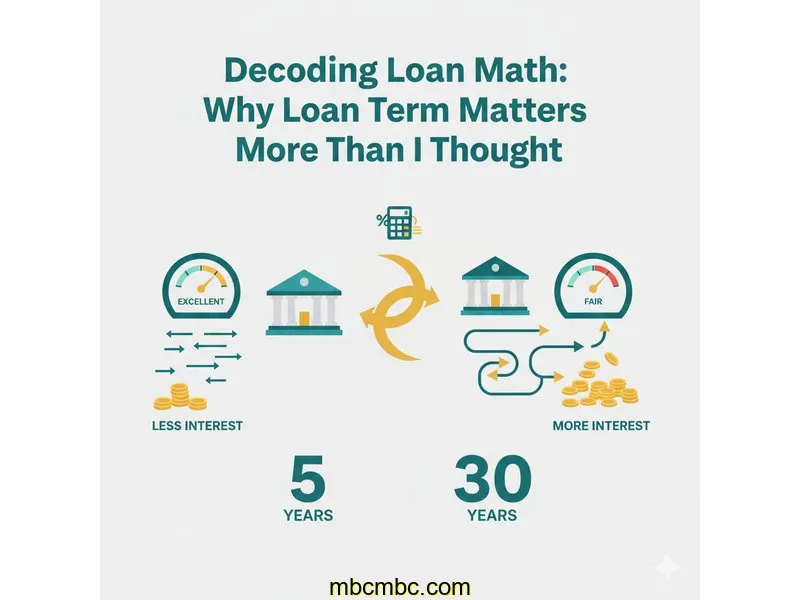
Auto Loan Calculator
Calculate payments over the life of your Loan
Home Blog Privacy Terms About Contact
Calculate payments over the life of your Loan
Home Blog Privacy Terms About ContactPublished on October 14, 2025

My journey down this rabbit hole started with a simple conversation. A friend and I were both thinking about home improvement projects, and we were idly browsing online loan calculators to get a sense of the numbers. I plugged in some figures for a hypothetical project and saw an option with a really manageable monthly payment. It felt affordable, almost too good to be true. But then I noticed it was for a 72-month term—six years. A shorter, 48-month option had a higher monthly payment that made me wince a little.
That’s when the question hit me: how could a lower payment possibly cost more in the long run? It felt counterintuitive. Was the bank just being nice by letting me pay less each month? Or was there some hidden math I wasn't seeing? I had always focused on whether I could afford the monthly bill, but I suddenly realized I had no idea how that number was connected to the loan's overall cost. It was a genuine moment of curiosity that I couldn't shake.
I decided then and there that I wanted to understand the mechanics behind it. I wasn't looking for financial advice or trying to decide on a real loan; I just wanted to demystify the numbers for myself. How do they calculate interest over time? Why does changing the number of months have such a dramatic effect on the total? This article is my documentation of that learning process. It's about understanding how calculations work, not about making any specific financial decisions.
My first attempt to solve this puzzle was a complete mess. I thought I was pretty good at basic math, so I decided to calculate the interest myself to see if I could match what the online tools were showing. I figured it had to be a straightforward formula. For my test case, I imagined a loan for $16,850 at a 7.2% annual interest rate over 48 months (4 years).
My logic went like this: Interest is the rate times the principal, over time. So, I did this calculation: $16,850 (Principal) × 0.072 (Rate) × 4 (Years). The result I got was $4,852.80 in total interest. I felt pretty confident. In my mind, the total amount to be repaid would be the original loan plus this interest, which was $16,850 + $4,852.80 = $21,702.80. Divided by 48 months, that would be a monthly payment of about $452.14.
But when I punched the exact same numbers into an online loan calculator, the results were completely different. The calculator showed a monthly payment of around $408.82 and, more shockingly, a total interest paid of only $2,773.36. My calculation was off by over $2,000! I was stunned. I checked my multiplication, I re-entered the numbers, but the gap remained. How could my simple, logical formula be so incredibly wrong?
This was my point of frustration. I wasn’t just a little bit off; my understanding was fundamentally flawed. The calculator had fields like "Total of Payments" and "Amortization Schedule" that I had always ignored. I realized the magic—and my misunderstanding—was hidden in how interest is calculated month by month, not as one big chunk at the end. My simple formula treated the entire $16,850 as the basis for interest for all four years, but that couldn't be right, because I'd be paying it down over time. I knew I was missing a key concept.
Determined to figure this out, I decided to stop trying to invent the formula myself and instead focused on how the calculators worked. I found a detailed one that had input fields for the loan amount, interest rate, and loan term, but it also showed the outputs very clearly: monthly payment, total interest paid, and total of all payments. This is where I had my breakthrough.
Instead of just looking at one scenario, I started to play with just one variable: the loan term. I kept the $16,850 loan amount and the 7.2% interest rate the same. First, I set the term to 48 months. The calculator confirmed the numbers I saw before: a $408.82 monthly payment and $2,773.36 in total interest. Then, I changed only the term, stretching it to 72 months. The monthly payment dropped significantly to $288.60, which looked very appealing. But then I looked at the other field. The total interest paid shot up to $3,929.20. Seeing those two scenarios side-by-side was the "aha!" moment. A lower monthly payment came at the cost of over $1,155 more in interest.
My biggest conceptual error was in not understanding amortization. I assumed interest was charged on the original $16,850 for the entire loan period. The reality is that interest is calculated on the outstanding balance each month. So, after your first payment, the principal balance drops slightly. The next month, the interest is calculated on that new, lower balance. This process repeats every month, which is why my simple "P x R x T" formula was so inaccurate.
This became my North Star. I realized that while the monthly payment tells you about your cash flow, the "Total Interest Paid" field tells you the actual cost of the loan. It’s the fee you pay for the privilege of borrowing. Once I started focusing on this number, comparing different loan scenarios became incredibly clear. I could instantly see the financial trade-off between a shorter term (higher monthly payment, lower total interest) and a longer term (lower monthly payment, higher total interest).
The final piece of the puzzle was clicking the "Show Amortization Schedule" button. It generated a huge table showing every single payment for the life of the loan. For the 48-month loan, I saw that the very first payment of $408.82 included $101.10 of interest and only $307.72 of principal. But by the last payment, only $2.44 was interest, and $406.38 went to principal. Seeing this shift visually demonstrated how I was slowly chipping away at the principal and paying less interest over time.
To really cement my understanding, I ran a completely different scenario: a $12,500 loan at 6.5% interest. Comparing a 36-month term to a 60-month term, I saw the same pattern. The longer term dropped the monthly payment but added hundreds of dollars to the total interest paid. I was no longer confused; I could confidently predict what would happen when I changed the term, and I understood the underlying math causing it.
This whole experience was incredibly empowering. Going from being completely baffled by a calculator to understanding the mechanics behind it felt like a huge win. I didn't become a financial expert overnight, but I gained a new level of literacy about how these calculations actually work. Here are the key lessons I learned about the math itself:
From what I've learned, it's because you are using the lender's money for a longer period. Even though your principal balance is decreasing, you are making more individual payments, and each one includes an interest charge. Those smaller interest charges over many more months add up to a significantly larger total amount than the larger interest charges over fewer months.
In my learning journey, the most insightful field was "Total Interest Paid." This number strips away the principal and shows you the raw cost of borrowing. Comparing this value between two loan options with the same principal amount is a very direct way to understand which calculation structure is more expensive over the long term.
It provides a payment-by-payment breakdown. You can see how the portion of your payment going to interest is very high at the beginning and gradually decreases, while the portion going to principal starts small and grows. This helps you understand that in the early years of a loan, you are making less progress on paying down the actual debt than you might think.
For standard amortizing loans, most calculators use the same core mathematical formula, so they should give very similar results for the same inputs (loan amount, rate, term). However, some calculators may have extra features, like options to include fees in the APR or model extra payments, which can cause results to differ. It's always good to try a couple to ensure the numbers are consistent.

My biggest takeaway from this whole exploration is that the story of a loan isn't told by its monthly payment. That's just the headline. The real story is in the total interest paid—the number that shows the true cost of borrowing someone else's money. It was a shift in perspective from focusing on short-term affordability to understanding long-term cost.
Spending a few hours playing with online calculators and digging into why my own math was wrong was more educational than I ever expected. It replaced a vague sense of confusion with a clear understanding of the cause-and-effect relationship between loan term, payments, and total cost. I’m not an expert, but I no longer feel intimidated by these numbers. I feel empowered to ask the right questions and look at the right figures.
I hope sharing my learning process encourages others to get curious too. You don't need to be a math whiz to grasp these concepts. With a little bit of curiosity and the right tools, anyone can learn to decode the language of loans. This article is about understanding calculations and using tools. For financial decisions, always consult a qualified financial professional.
Disclaimer: This article documents my personal journey learning about loan calculations and how to use financial calculators. This is educational content about understanding math and using tools—not financial advice. Actual loan terms, rates, and costs vary based on individual circumstances, creditworthiness, and lender policies. Calculator results are estimates for educational purposes. Always verify calculations with your lender and consult a qualified financial advisor before making any financial decisions.
